Outside of military skills training, historical studies are important to the military, they can help understand tactics and provide opportunities for reflection.
In the summer, Reservists from 37th Signal Regiment travelled across the Channel for a Battlefield Study to learn in-depth knowledge about the Soviet advance from Poznan to Berlin in 1945.
Their five-day visit took them to key former military structures and locations of historical importance. Guided daily by Lieutenant Susie Rotherforth, Professor Mattheus Strohn and Nigel Dunkley, Reservist Staff Sergeant Tricia Cavanagh-Wilkinson shares the knowledge their guides imparted with their regiment in her fascinating account below.
Tricia said: “On arrival in Poznan, Poland, we went straight to Cytadela Memorial Park where Lieutenant Rotherforth pointed out various remnants of the Fort Winiary Fortress and highlighted that the park now has a number of art installations with the theme “Life Goes On”.
“We had lunch in Umberto Restaurant which was a telecoms bunker during WW2, before being introduced to the history between Poland and the Soviet Union, along with the Battle of Poznan, whilst sitting next to the impressive Soviet war memorial.
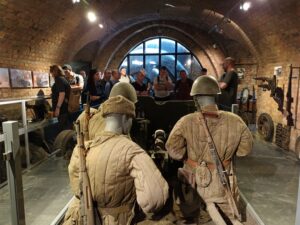
“Poznan had been given ‘Festungen’ or fortress status by Hitler, meaning the German Garrison based there had to defend it at all costs. They did this by using the existing fortifications which included a 5km ring of forts around the city and Fort Winiary which stood on a hill at the centre. General Zhukov’s offensive to take Poznan began on 21st January 1945 and it took his troops four days to penetrate the defensive ring, however, it then took six Soviet divisions until 22nd February 1945 to fully take Poznan.
“We also visited the Museum of Armaments where we had a guided tour and learnt about the history of the Polish Commandos. To finish the day we went to the nearby Commonwealth War Graves Commission (CWGC) cemetery and paid our respects by laying a wreath. It was a long, hot, but very informative day.
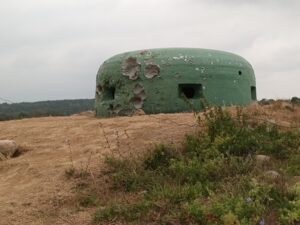
“On day two we visited Bunker 717 in Miedzyrzecz, known as Ostwall, where Prof Strohn briefed us that the bunkers were part of the fortified military defence line for the Nazis. They were 110km in length running between the Oder and Warta rivers. It was the most technologically advanced bunker system in Nazi Germany.
“We were privileged to have a guided tour inside the bunker and tunnel system which covered approximately 3km. We weren’t really prepared for the darkness and the bats inside the tunnels. It was a fascinating tour and we found out that the bunker and tunnel system, which was 50m below ground, was built in approximately 10 years in order to create jobs for the German population. During WW2 however, by the time the Soviets reached the bunkers as part of the Vistual-Oder offensive there weren’t enough German Troops to defend the line and the Soviets took it in three days. Once back out in the daylight we looked at the dragon’s teeth defensive line and had lunch at Bunker King which wasn’t a patch on its namesake.
“Afterwards we moved to Kustrin which was the last Festungen before Berlin, and the location of the only bridge for many miles across the River Oder. Kustrin had been a fortified settlement for over 1,000 years and due to its strategic position in WW2 it was subjected to heavy bombing. The Soviets took two weeks to take Kustrin and to do so, had to almost destroy it completely with artillery. The Nazis were using water mines to prevent the Soviets crossing the river but ultimately the Soviets captured the town on 11th March 1945. We were able to see the foundations of some of the buildings within the Altstadt, or old town, during a walking tour of the site.
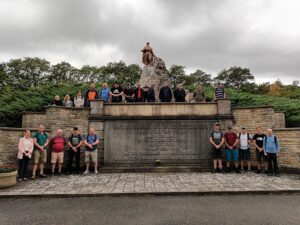
“Our third day was a journey to Seelow 90km east of Berlin to discuss the Battle for Seelow Heights. With the impressive Soviet War Memorial as a backdrop and a good view of the battlefield, Professor Strohn talked us through the events.
“The Nazis had three lines of defence, a system we still use today called “defence in depth”. On 16th April 1945 one million Soviet troops of the 1st Belorussian Front (compared with 150,000 German Troops) commanded by General Zhukov unleashed 9 million artillery rounds onto the first line of defence. However, the Germans had already mostly vacated this line and further flooded the terrain to slow the Soviet advance.
“This tactic worked as several Soviet tanks became bogged down and there were high numbers of Soviet casualties. This led General Zhukov to deploy his reserve armies much earlier than planned but eventually they were able to gain ground and reach the second line of defence on the same day. Due to General Zhukov being in a race to Berlin with General Konev and his 1st Ukrainian Front Armies, Zhukov pushed his troops on further, almost immediately they succumbed to heavy casualties taking the second line of defence, but by nightfall on 18th April 1945 he had reached the third and final defensive line, Seelow Heights. The next day the Soviets broke through, meaning there were now no major defensive positions between the Soviets and Berlin.
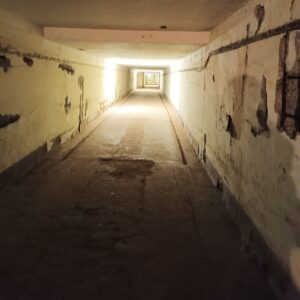
“Moving on from Seelow we travelled to Zossen and Zeppelin Bunker which was the German Army’s Supreme Command and the biggest communications bunker in the world at the time. We were lucky to have a guided tour of the bunker both above and below ground which led us down more tunnels, and allowed us to see just how vast the area was. The Germans used inventive camouflage to hide the entrances to their bunkers in the form of houses that people actually lived in.
“There were approximately 500 German troops working there on the telephone and data systems but it had been abandoned by the time the Soviets arrived, and they took it without any fighting. After the war The Soviets built a 70km wall around it, and it became one of their Forbidden Cities housing 50,000 troops for many years. Our last stop of the day was the Deutchce-Russisches Museum with the ‘Surrender Room’ where the surrender agreement was signed between the Allied Forces and Germany. It was hard not to feel a little in awe of standing in such a historically important space.
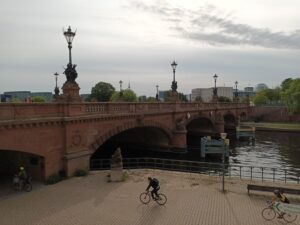
“By the beginning of day four we were now into the Berlin phase of the advance. After a briefing on the intense, hand-to-hand and street-by-street nature of the fighting that took place, we moved to the Moltke Bridge. The bridge over the River Spree was the final natural barrier between the Soviets and the Reichstag.
“Our Berlin guide Nigel Dunkley set the scene for the final Soviet push before we moved across the river, over the location of the tank trap dug by German troops and onto the Reichstag. By this point Hitler had committed suicide but the Germans chose to fight on. As fierce fighting was taking place within the building, two Soviet soldiers were tasked to take the flag onto the roof to claim victory. They managed to find their way and at approximately 23:00 they draped the Red Banner No.5 from the top of the Reichstag, however, as it was dark the famous colour photo we know today was actually staged the next day using borrowed US colour film.
“The rest of the day in Berlin moved away from the Soviet advance with a journey to Tiergarten Soviet War Memorial which is made from the stone of Hitler’s Chancellery, and is the resting place of 2,000 Soviet soldiers.
“Our next stop was the 1936 Olympic Stadium where we took a photo with the original Olympic Rings in the background and climbed the bell tower to give us amazing views across Berlin. We were also lucky enough to gain access to Langemark Hall where Hitler had his own private memorial to German soldiers lost in WW1.
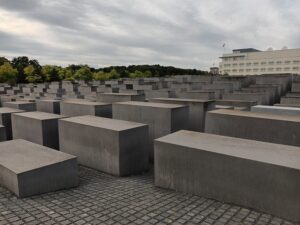
“In Heerstrasse, we visited a CWGC Cemetery to lay a wreath to the fallen British and Allied Airmen that make up the majority of the 3000 graves. Nigel then led us to the German Resistance Memorial Centre, the location of General Claus Von Stauffenberg’s execution after the failed Op Valkyrie in which he and his team had attempted to kill Hitler at the Wolfs Lair. We visited the Memorial to murdered Jews in Europe before ending the day at the Fuhrerbunker.
“Even though the bunker itself has been filled in and is now a car park it was still quite eerie standing on the spot, where 50m underground Adolf Hitler had committed suicide. An information board at the site showed just how big the bunker had been – even having its own hospital and vehicle park. We know that Hitler’s body was burned outside the bunker and that eventually it was picked up by the Soviets who still have some of his teeth and part of his skull in Moscow.
“The final day of our study began at Platform 17 which was a Holocaust deportation railhead; the platform was hidden from the main entrance to the station so that German citizens couldn’t see what was happening. It is thought that 55,000 Jews were taken out of Berlin to concentration camps including Auschwitz, 35,000 of those died. It is an extremely sombre and thought provoking place, especially walking along the installations that show the date, number of Jews deported and their destinations – which happened on a daily basis at times.
“We visited the Allied Museum and received a briefing from Nigel on Op Brixmis during the Cold War, in which he made regular intelligence gathering trips into East Germany taking photos of Soviet kit and equipment. He also gave us detail on the UK safe house in Potsdam (a Soviet area) that was heavily bugged by the Soviets, including the toilets!
“Our final stop was Checkpoint Charlie where Nigel took us through the tank standoff in 1961. Then we moved nearby to the Topography of Terror Museum which charts the Nazi Party from 1933 through to the end of the Reich. It is safe to say that there is information and photographs of Nazi atrocities in this museum that will stay with us forever.
“It is from here we began our long journey home. We were lucky enough to be part of five days of an outstanding military study period, led by unit staff and supported by world class experts; an unforgettable experience.”
Find out more about the Reserve Forces.
Find out more about 37th Signal Regiment.
Published 01/02/2023

